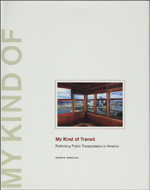July 09, 2009 Categories: Reviews
My Kind of Transit: Rethinking Public Transportation in America
2008. Center for American Places at Columbia College Chicago. 175 pp. $27.50
This is a book of one idea and many examples. Once stated, the idea is so obvious that it’s hard to believe no one has systematically presented it before: public transportation should strive to be as appealing as the destinations it takes us to. (How else to compete with the speed, convenience, and privacy of the private automobile?) In other words, transit has real potential to be in itself a setting for public life. Think of this book as a missing chapter from Ray Oldenburg’s classic description of “third places,” The Great Good Place.

Nordahl, who is “city designer” at a design center in Davenport, Iowa, has appreciative comments on transit in Disneyland (monorail, omnibus, streetcars), San Francisco (cable cars and streetcars), New Orleans (streetcars), Seattle (monorail), Santa Barbara (shuttle), New York City (taxi cabs and an aerial tramway), and Pittsburgh (funiculars AKA “inclines”). Less successful in his view are the Las Vegas monorail, Phoenix and Chattanooga’s shuttles, and the Chicago el (which is berated at length).
The book’s eight chapters of examples are sandwiched between an introduction and a lengthy conclusion that elaborates on 13 aspects of transit design — factors that could be optimized to make transit an intrinsically desirable experience in itself. The author favors transit that follows indirect routes and takes its time on them, has short headways, is not too large or automated, has big openable windows, is colorful, has seating that promotes sociability, and has something to do with the place where it is.
Since even bare-bones utilitarian transit has never been adequately funded, and is unlikely to get more money in a recessionary economy, it’s disappointing that Nordahl rarely comes to grips with the tension between his recommendations and the dictates of efficiency. (He does address the issue in the case of size, proposing double-decker buses, which can be intimate spaces and still carry large numbers of people.) But in general, his case is not strengthened by his decision to lead with Disneyland, which is not a city and which by definition caters to tourists — why should they mind if the monorail wanders all over the park on its way to Tomorrowland? He follows up with San Francisco and New Orleans, which are already major tourist destinations. It will take some heavy lifting to make the case for fun transit in Indianapolis, Buffalo, and Salt Lake City.
Nor does the book altogether avoid the curse of the Mediterranean. Many designs and situations that promote public life happen outdoors, and they function ideally in climates where it’s a pleasure to be outdoors in the first place. Almost all of Nordahl’s examples are taken from moderate climates. A Midwest-based designer who has nothing to say about winter isn’t thinking hard enough.
The author’s choice of sources in the general transportation literature is questionable (at one point he describes Jane Holtz Kay’s one-sided and error-riddled Asphalt Nation as “seminal”). But policy discussion takes up only a small part of the book. The point is to get the ball rolling, and Nordahl has done that in style. Now it’s up to more designers to step across a few boundary lines and get even more specific about how to make the bus, the train, and even the el a place we hate to leave.
#
